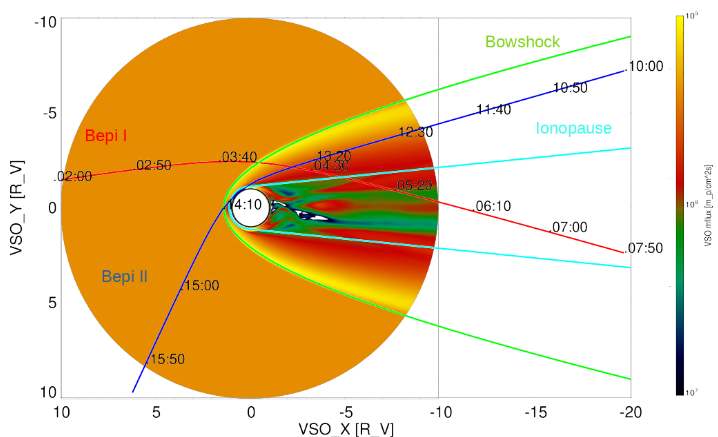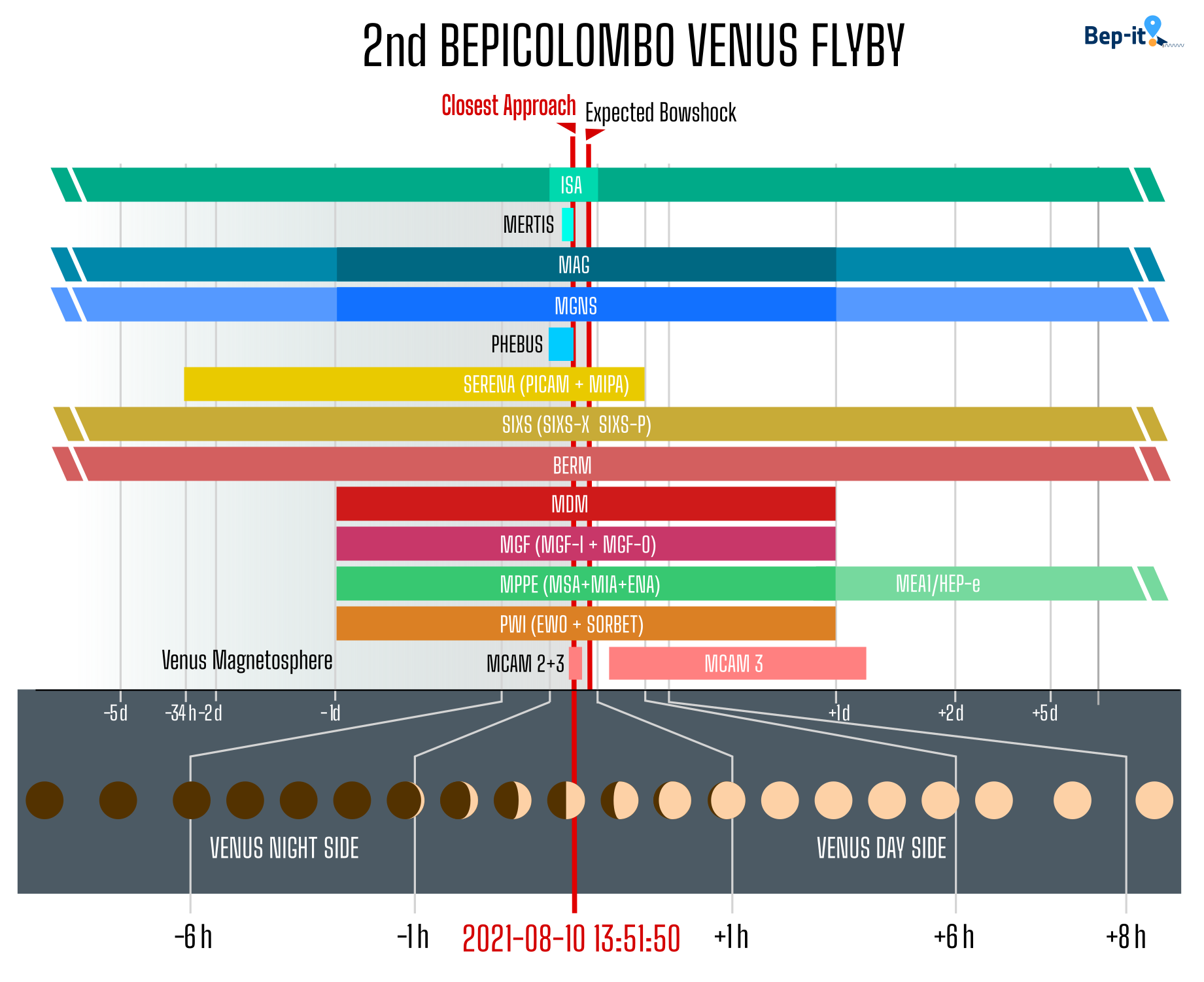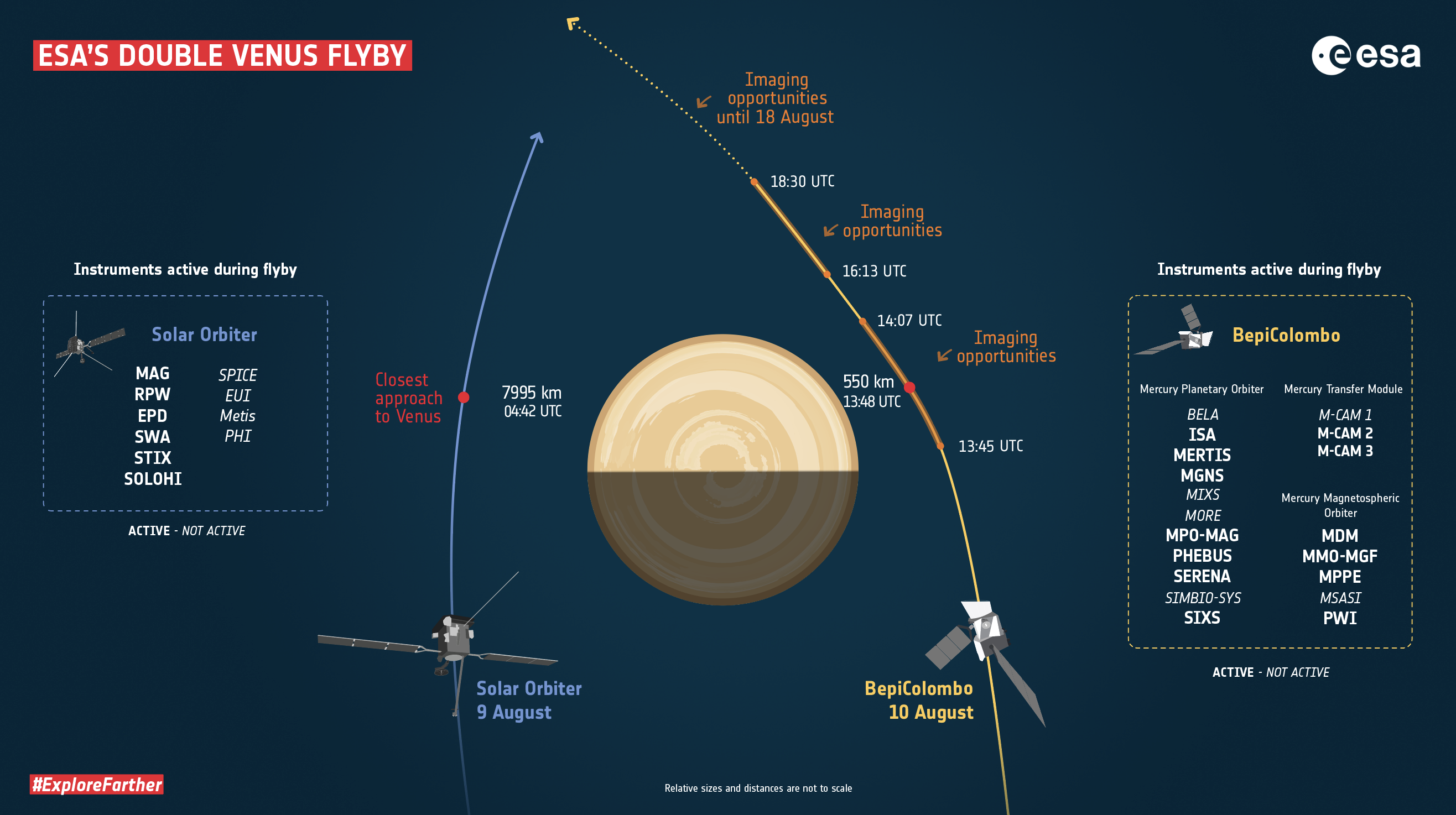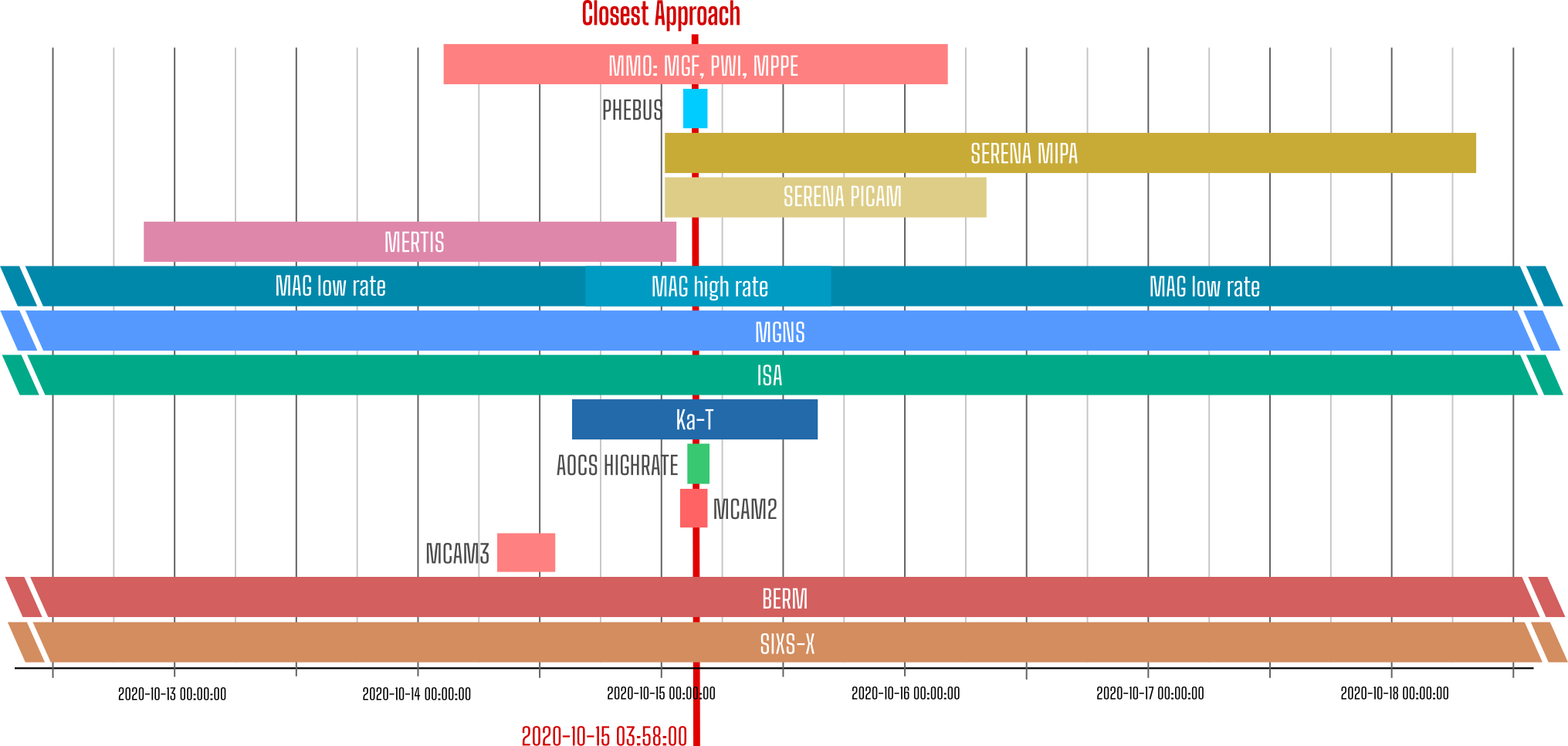BEPICOLOMBO VENUS FLYBYS
Now also the second Venus flyby is happily concluded!
Here below you may find all the information we provided before the event, with the planning.
At the moment, we are all busy analyzing data.
First images and measurements will be shown on the VFB2 first data sub-page, and on Twitter at the official ESA channels.
Information in a nutshell
|
Date |
15 October 2020 |
10 August 2021 |
|
Closest approach |
03:58 UTC |
13:51 UTC |
|
Minimum Altitude |
10720 km |
552 km |
|
Operation time |
about 2 days before and 2 after Closest Approach |
about 2 days before and 2 after Closest Approach |
|
Payloads Operated |
MMO: MPPE, MGF, PWI MPO: ISA, MERTIS, MGNS, MORE, MPO-MAG, PHEBUS, SERENA, SIXS, BERM MTM: MCAM2, MCAM3 |
MMO: MPPE, MGF, PWI, MDM MPO: ISA, MERTIS, MGNS, MORE, MPO-MAG, PHEBUS, SERENA, SIXS, BERM MTM: MCAM2, MCAM3 |
The flybys geometry
The images below show the flyby trajectories of BepiColombo at Venus on October 15th 2020 (Bepi I,red) and August 10th 2021 (Bepi II, blue) as they were calculated and published in early 2020 (for more details see Mangano et al., 2021). Final timing is slightly different, but the geometry remains the same.
Figure 1 shows the projection onto the VSO (Venus Solar Orbital frame) X-Y plane (-Y up); Figure 2 shows the projection onto the X-Z plane. Numbers plotted along the orbits give the expected universal time. Green and cyan profiles show average positions of bow shock and ion composition boundary respectively (as modeled after Martinecz et al., 2009).

Figure1: Venus flybys trajectories in XY plan, VSO system (courtesy of Markus Fraenz, MPI, Goettingen, Germany). Note that Y axes are increasing downwards. Units are in Venusian Radii.

Figure 2: Venus flybys trajectories in XZ plan, VSO system (courtesy of Markus Fraenz, MPI, Goettingen, Germany). Units are in Venusian Radii.
Simulated ion mass fluxes are also mapped in the background as derived by using the code PLUTO (Mignone et al., 2007, 2012 http://plutocode.ph.unito.it/ ) for average solar wind conditions (orange circle, corresponding to a value of mass flux of about 5 10^8 p/cm^2 s), and ionospheric parameters as in the colorbar to the right.
2nd Venus Flyby
The second flyby at Venus will take place on August 10th, 2021, about 10 months after the first (October 15th 2020). The much lower altitude above the surface (552 km) will allow a different range of investigations. Moreover, Venus will be approached from the nightside (differently from the 1st flyby), though still approaching the planet from the evening terminator (i.e. on the same side of the planet as for the 1st flyby).
Here below a timeline shows the time of operations of all the instruments onboard BepiColombo that will acquire data:

Credits: Valeria Mangano and Carmelo Magnafico IAPS-INAF - Rome
As it can be noted, and for what concerns the planetary investigations of Venus, some instruments will acquire data mainly in the 2 days around the flyby (like MERTIS, PHEBUS, SERENA, SIXS and MPPE, PWI, MGF, MDM) while others like ISA, MAG, MGNS and BERM are operating almost continuously during the cruise, but in shorter periods, around the closest approach, will turn to high resolution modes to optimize the scientific income. Finally, the two monitoring cameras MCAM2 and 3 will be switched on at and after the closest approach to give us images of the event.
The peculiarity of this flyby lies in the occurrence of another flyby at Venus 1 day earlier by another ESA spacecraft. Solar Orbiter, in fact, will flyby Venus on August 9th at 04:42 UTC, about 33 hours earlier. It will pass by Venus at a minimum altitude of 7995 km, and on the other side of the planet (facing the morning side).

Credits: European Space Agency, link
The image above shows the geometries of the two spacecraft and the different instruments that will be operated.
The almost-contemporaneous measurements of the two spacecraft will allow additional science to better understand the interactions between the solar wind and the complex environment of Venus.
The potential Scientific Investigation are discussed here.
1st Venus Flyby
After the instrument tests performed during the Earth flyby on April 10th 2020, the first Venus flyby was the first occasion to use instruments for scientific purposes in a planetary environment.
The flyby at Venus occurred on October 15th, 2020, almost 2 years after launch, at 03:58:31 UTC (Closest Approach, CA).
As Figure 1 shows, BepiColombo approached the planet from the dayside and – given the retrograde rotation of Venus - it had the closest approach on the evening terminator, almost at the time of crossing the bow shock.
Minimum distance from the center of the planet was 16771.5 km (that is an altitude of 10720.5 km above the planet surface). The distance of Venus from the Earth was 1.16 AU and from the Sun 0.71 AU.
Apparent angular size of the planet as seen from BepiColombo was about 42° at the CA.
Hence, the flyby occurred at an altitude of about 2 Venus radii, and the spacecraft was expected to cross the bow shock near the CA time; the ionopause, instead, was crossed later, when already in the tail region, for the first time, at < 10 RV (when entering), and a second time much later (at the exit). Exit from the bow shock occurred even later.
The flyby configuration was optimal for both atmospheric and ionospheric/magnetospheric investigations of the Venus close environment.
Instruments on board operated in the days around the Venus closest approach (15th October 2020) according to the following timeline:

As it can be noted in the timeline, and for what concerns the planetary investigations of Venus, some instruments were acquiring data only in the hours around the flyby (the magnetometer and other sensors onboard MMO, PHEBUS, SERENA/MIPA and /PICAM, MERTIS, SIXS) while others like MAG, ISA, MGNS, BERM and MORE were operating almost continuously during the cruise.
The potential scientific outputs of these observations are discussed below in the Scientific Investigation [add link to section below].
Venus flybys scientific investigations
Multiple BepiColombo instruments will be operational during the cruise phase (see table on top of the page). In spite of the field of view limitations imposed on some of these instruments due to the stack configuration of Bepi spacecraft components, several science investigations will be conducted at Venus. These investigations will focus on the following topics:
- Atmosphere (<150 km altitude): In the 2020 and 2021 close encounter periods, and in selected periods where BepiColombo is between 0.3 and 0.8 AU from Venus, Venus’s atmosphere will be observed by MERTIS (the 7-14 µm infrared spectrometer and 7-40 µm radiometer) and PHEBUS (the 4-channel UV spectrometer). The data obtained by the MERTIS instrument is sensitive to Venus’ middle atmosphere and cloud layers, providing temperature profiles and detecting CO2, SO2, H2SO4 cloud aerosol properties. Data obtained by MERTIS during the flyby observations will contribute to studies of Venus’ radiative balance, atmospheric structure, cloud level chemical processes, and the impact of global-scale atmospheric waves on Venus’ weather patterns. The MGNS neutron and gamma spectrometers will also contribute to the investigation of Venus’ atmospheric chemistry and dynamics by detecting elemental composition in terms of C, O, N and H2O during both Venus flyby events. A few minutes before BepiColombo reaches closest approach on 10 August 2021, the PHEBUS spectrometer will be used to complete nightside atmosphere stellar occultations in the FUV channel (145-315 nm) providing density profiles of bulk and trace gas species, and detecting NO emission on Venus’ nightside. This data will be used to study the atmospheric structure between 80 and 150 km altitude, and the zonal transport processes in the thermosphere (at about 110 km). Faraway PHEBUS observations, occurring between 0.3 and 0.8 AU, will be used to characterize Venus’s disk-averaged UV and visible planet brightness and cloud top sulfur species abundances. BepiColombo’s Venus atmosphere investigations will be further supported by complementary observations completed by the Akatsuki spacecraft presently orbiting around Venus, and other Earth-based telescopes, expanding the scope of study to Venus' climate. To learn more click here
- Induced magnetosphere and Ionosphere: Venus has no intrinsic dipole magnetic field and thus the solar wind plasma can easily approach the planet and interact directly with the upper atmosphere, leading to the formation of an ionosphere, ion plasma boundaries and an induced magnetosphere. During the BepiColombo passage, the investigation of the extended region from the outer unperturbed solar wind, through the bow shock, the magnetosheath, ionosphere and magnetotail (during 1st flyby, and in the opposite direction during the 2nd), can be performed by several instruments onboard. First of all, the two magnetometers (MAG and MGF) may provide magnetic field measurements along the whole period. Then, a wide set of ion, electron and plasma sensors at different energy ranges of the particles suites: SERENA, PWI, MPPE. Their joint measurements of the different instrumentation will be fundamental to detect the position of the different plasma boundaries and the composition of the different layers of the complex ionized environment. Moreover, the potential detection of draped dayside magnetic fields, low frequency wave activity in the ion composition boundary, flux ropes and tail lobes polarity are all interesting potential measurements that deserve the effort of these measurements. Finally, measurements of energetic neutral atoms as derived from solar wind ion sputtering over the exobase, electron shielding effects and detection of atmospheric pick-up ions could help to relate the ionized and neutral components of the Venus environment and, hence, the induced magnetosphere with the atmosphere themselves.
To learn more click here
Venus flybys WORKING GROUP
The Venus Flybys Working group (VFBWG) aims to promote discussion on Venus science as related to the BepiColombo passages nearby the planet, and focus on the synergy of the different instrumentation onboard and its possible contribution to Venus science.
The working group also supports coordination of Venus observations among BepiColombo, other spacecraft, and Earth-based telescopes. Such efforts include observations by the Akatsuki Venus orbiter (JAXA) and by another ESA’s spacecraft, Solar Orbiter, which will make its Venus flyby one day before BepiColombo’s flyby 2.
Venus flybys working group splinters are organized now monthly, usually the day before or the day after the BepiColombo SWT meetings (now virtual). The participation to the working group splinters is open to all BepiColombo team members and welcome to all Venus experts.
WORKING GROUP contacts
Scientists interested to the Venus investigations and analysis to be performed with the BepiColombo instrumentation may contact us:
- BepiColombo Deputy Project Scientist: Joe Zender ESA - ESTEC Noordwijk, Netherlands
- WG Chair: Valeria Mangano, INAF-IAPS Roma, Italy
- Guest scientist: Kandis Lea Jessup, SWRI Boulder, CO, USA
- Guest scientist: Yeon Joo Lee, DLR, Berlin, Germany
The information above is provided by V. Mangano, J. Zender, Kandis Lea Jessup and Yeon Joo Lee.
The Page is maintained and styled by C. Magnafico.
Deputy Project Scientist: Joe Zender, ESA-ESTEC Noordwijk, Netherlands email
Venus flybys WG Chair: Valeria Mangano, INAF-IAPS Roma, Italy email
Guest scientist: Kandis Lea Jessup, SWRI Boulder, CO, USA email
Guest scientist: Yeon Joo Lee, Technische Universität Berlin, Germany email
ISA payload CO-I: Carmelo Magnafico, INAF-IAPS Roma, Italy email
OTHER useful INFORMATION
- ESA science BepiColombo page
- ESA COSMOS page on BepiColombo
- JAXA Mercury Magnetospheric Orbiter MIO page
- ESA service "Where is BepiColombo now?"
- ESA SPICE video on Venus flyby#1
- SPOT simulator of Venus flyby #1
- SPOT simulator of Venus flyby #2
- BepiColombo italian outreach (Bep-it!) page (in italian)
- The BepiColombo mission to Mercury: special issue on Space Science Reviews 2020 here (and in particulare the BepiColombo cruise & flybys science paper).
- ESA COSMOS page on BepiColombo instrumentation here.








































 Sign in
Sign in
 Science & Technology
Science & Technology